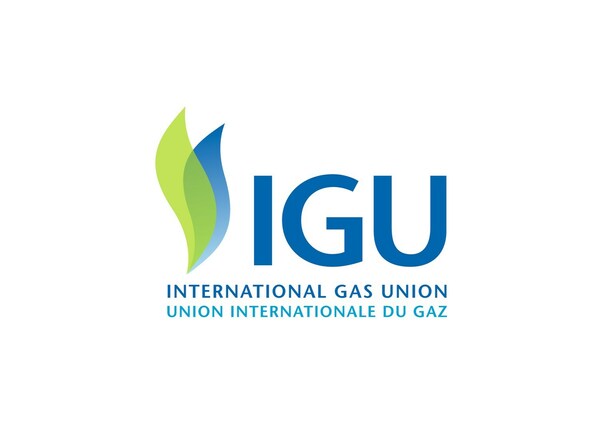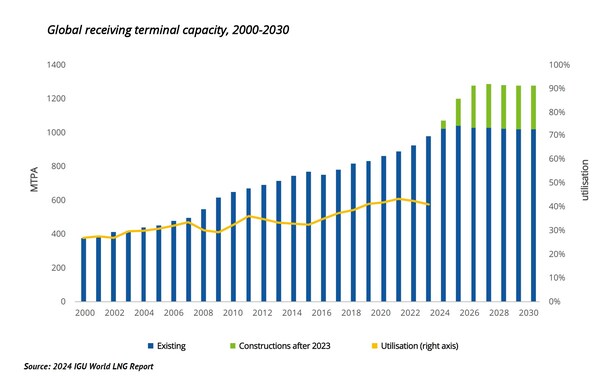PR NewsWire | Jun 26 2024
 |
LONDON, June 26, 2024 /PRNewswire/ — Released today, the IGU’s 15th annual World LNG Report finds that global LNG trade grew by 2.1% in 2023, surpassing 401 million tonnes (MT). This global market now connects 20 exporting with 51 importing markets, while supply is currently the primary growth- limiting factor. After two years of severe turbulence, the LNG market has a newfound but fragile equilibrium, given lack of spare supply in the near-term.
LNG has become a critical component of the global energy mix, with its role as a flexible, highly efficient, and reliable resource continuing to grow, and as such, decarbonising the LNG value chain is a priority for many stakeholders in the industry. Several proposed projects are undertaking innovative emissions-reducing measures to meet this need by integrating renewable electricity, carbon capture and storage, partnering to develop e-methane, and grow bio-LNG, or liquefied biomethane, which is produced from capturing and upgrading biogas that would have otherwise been emitted from landfills, agricultural waste, or other feedstock.
LNG receiving capacity growth has been shaping market development over the past 24 months, as it reached an impressive 1,029.9 MTPA at the end of February 2024, adding almost 70 MTPA in 2023 and making it the highest year of new additions since 2010. Europe saw the greatest addition of 30 MTPA, followed by Asia’s 26.9 MTPA and Asia Pacific’s 13 MTPA. The Philippines and Vietnam joined the club of LNG importers in 2023 for the first time.
Supply remained constrained, with just 0.8% YOY growth from Indonesia’s 3.8 MTPA addition at Tangguh LNG. However, global liquefaction capacity is likely to grow to over 700 MTPA by 2030, driven by new FIDs and the start-up of projects currently under construction to support growing demand, particularly in the growing Asian markets, where coal to gas switching is important decarbonization and air quality improvement strategy.
LNG exports were dominated by the US, which became the largest producer and exporter (84.53 MT in 2023 vs 75.63 MT in 2022), followed by Australia (79.56 MT), Qatar (78.22 MT), and Russia (31.36).
2023 saw spot LNG prices declining to levels palatable for recovery of import growth in Asia, as Platts JKM averaged $13.86/mmBtu during the year, while average annual price volatility has significantly reduced from 2022 levels but remains above pre-crisis. China came back as the largest LNG importer at 71.19 MT, Japan and Korea remained second and third despite annual declines, and India came back to the fourth position, with more demand responding to the lower spot price. Europe also cemented its role as an LNG importing heavyweight, maintaining the second-largest importing region spot at 121.29 MT in 2023. With LNG supplying almost half of Europe’s gas, the competition between Asian and European markets remains as key market dynamic.
Global LNG market continues to rapidly evolve as it responds to growing gas demand in emerging markets, increasing number and diversification of market participants, and the acceleration of technology development and innovation. LNG industry is no longer a game only for big markets or big companies, with portfolio players playing an increasingly more important role. In 2023, about 180 companies were involved in LNG deliveries under term contracts, while about 35% of the transactions were spot-priced.
However, several major uncertainties confront the supply-constrained market, contributing the fragility of its current equilibrium. Key sources of this uncertainty include: the Biden Administration non-FTA LNG project approvals pause, which could delay over 70 MTPA of new capacity; sanctions on Russian LNG, which impact almost 20 MTPA of expected capacity; the possibility that Ukraine may not extend the Russian gas transit deal at the end of 2024; shipyard bottlenecks; the ongoing security risk in the Middle East; as well as some declining gas field supply. Over 120 MTPA of currently operational liquefaction capacity is over 20 years old, and some of these facilities are being mothballed due to insufficient upstream gas production, which calls for attention to the supply side risk.
IGU President, Li Yalan stressed:
The LNG industry has demonstrated incredible agility and innovation through some of the toughest tests over the recent years, and this is an industry that continues to play a pivotal role to navigate through an energy crisis that has not yet been fully resolved and an energy transition that has been challenged.
As the world moves toward a low emissions future, nations are seeking ways to achieve their climate commitments while keeping energy affordable, available, and secure. LNG is a tool that will be critical to providing greater resiliency for rapidly changing energy systems around the world, and it will have an essential role mitigating the inherent risk of uncertainty through that process.
About the Report
Leveraging the IGU’s vast global gas value chain network across 80 countries, the report provides the most authoritative public data and analysis on LNG trade, price, liquefaction, regasification, shipping, bunkering, as well as key developments impacting the global LNG market.



